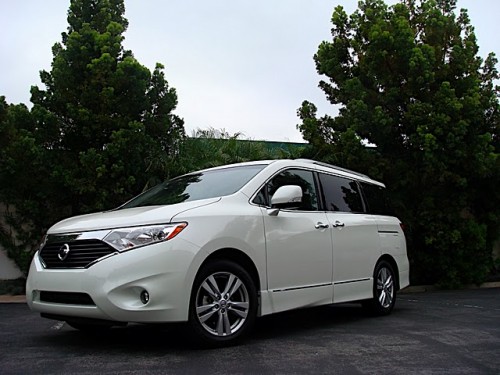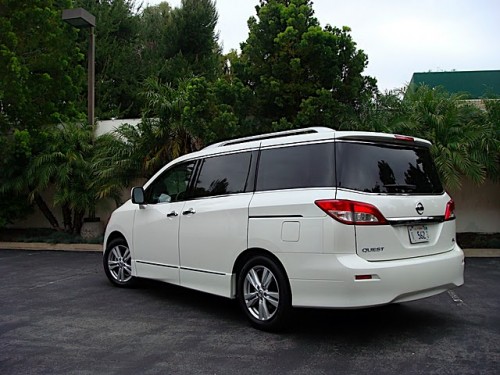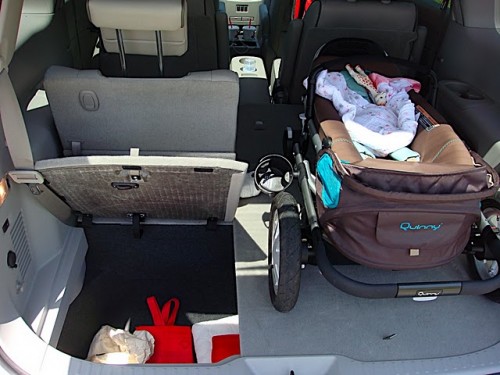2011 Nissan Quest: VIP Transit for the Whole Family
- June 23, 2011
- Nissan, On The Road: Driving Impressions
- Posted by Ed Kim
- Comments Off on 2011 Nissan Quest: VIP Transit for the Whole Family
The fourth generation Nissan Quest launched for the 2011 model year, marking a dramatic departure from the prior model. The last Quest was developed and conceived specifically for North America (and built here too), riding on a version of the Altima sedan’s platform. While a very able minivan, it never truly caught on. Perhaps its was styling, both inside and out, that was too aggressive or avant garde for traditional minivan customers.
With the latest Quest, Nissan stepped away from the traditional American minivan template and moved production back to Japan, commonizing it with the Japanese-market Elgrand people mover, albeit with revised front and rear styling more in line with American tastes.Why is this significant? Well, for one, the Elgrand has a very different mission statement in its home market compared to its Americanized Quest sibling. It often serves as executive transport for Japanese bigwigs, rather than the somewhat less glamorous kid taxi duty it performs in this market. What this means for the driver is that compared with its competition, the Quest drives like a luxury vehicle by comparison.
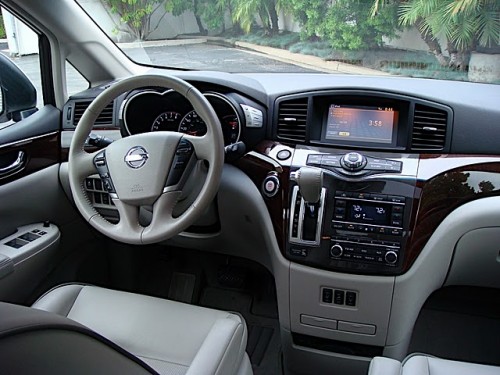
No, we’re not kidding. The interior is hushed at all speeds, and the 3.5L V6 and CVT transmission work quietly and harmoniously together. The ride quality is superb, with the suspension smothering road imperfections with a plushness not usually seen in this segment. Even the steering feels luxurious, with a solid heft and excellent precision. The way that it regally wafts down the road is a soothing reminder of its Japanese cousin’s role in its home market. In the end, American families benefit.
The interior materials reflect much the same too. Rich, soft-touch materials abound where most other minivans counter with hard plastic, and the soft leather in our test vehicle felt more Infiniti than Nissan grade.
Because of its Japanese market roots, Quest looks unique, quite unlike the typical minivan. It looks tall and boxy, as per the Japanese people mover norm, but there is something ever so slightly menacing about its look Perhaps it’s the vertical, wraparound rear glass, or the almost-aggressive body kit. One could almost imagine it lowered, with over-sized wheels, transporting a group of Yakuza through town.
So it feels luxurious and looks unique, but now does it function as a family minivan? Mostly pretty well. Subjectively, it feels a little smaller inside than the segment leaders, but not by much. The cargo area is unique in that it features a large well like most other minivans, but the third row seat does not fold into it, making that well always available for cargo whether the third row is in use or not. Furthermore, there are removable covers over the well, helping to keep valuables neat, organized, and out of site.
We have three major gripes with the interior. The first relates to sliding doors, Yes, they are power operated, as per the segment norm. But why are the openings so small? The sliders simply don’t roll back very far, leaving a relatively small vertical mailslot of an entry into the cabin when the doors are open. The openings were so small in fact that loading an infant carrier was far more challenging than it ever should be in a minivan.
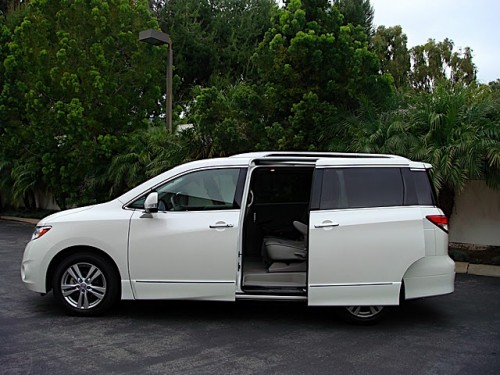
Second, while both second and third rows do fold flat, they fold above the floor rather than into it. This means that the ability to carry large and bulky items is compromised since those folded seats effectively raise the load floor by a significant amount. Finally, satellite radio was only available on the LE model, not on our SL. For 2012 MY, Sirius XM will be added to more trim levels.
Aside from those three issues, however, the new Quest is an intriguing vehicle for the fact that it strays a bit from the ubiquitous North American minivan template, and yet mostly checks the requisite boxes for the segment despite its relative uniqueness. This minivan actually has some personality in a segment renowned for its dullness, and its luxurious drive character could prove to be a soothing counterpoint to all that ruckus coming from the kids fighting in back. In the end, that is perhaps the Quest’s biggest differentiator…and given the stressful lives of American families today, it’s a very compelling one.
SECOND LOOK FROM DAVE SULLIVAN: This Quest doesn’t evoke any memories of the Mercury Villager for me after I recently had the opportunity to put over 1,000 miles on one and see how it could handle moving my family around during the 4th of July vacation.
My daughter’s Recaro YoungSport was a snap to install into the captain’s chair. I was able to fold down the third row and pile our stuff in for the weekend. Anyone who has used folding seats in a crossover will appreciate this feature. The bath tub-sized hole behind the third row is impressive. I loved using the tub for groceries and keeping things out of sight. A $300+ trip to Costco couldn’t even come close to filling the tub up.
The interior has some of the nicest materials of any minivan on the market. It’s so nice that this van could easily be badged an Infiniti in the higher trim levels. The ride is comfortable and this is where the CVT transmission shines. You can still put the pedal to the metal and not get apple juice all over the place. The transmission never shifts…it’s just smooth acceleration. The CVT also keeps the engine running at a fairly low RPM, resulting in a very quiet ride. Again, the CVT may not be great in a performance application, but for smoothness and refinement, it is right at home in the Quest.
The DVD rear entertainment system worked superbly. I was able to listen to Disney’s The Little Mermaid over and over. Maybe it worked too well. There are headphones but my daughter is too young for them. The screen is motorized and has an adjustable angle to adapt to people sitting in different rows. It also adapts to ambient light. Slick! The USB audio input is fantastic, like most Nissan and Infiniti vehicles today, and this was my reprieve between movies because we didn’t have the LE model with Sirius XM.
I have a few issues with the Quest. First, why can’t I get blind spot detection on the lower trim levels? Where are the rain sensing wipers? Come on now.
Second, the Toyo tires have to go. The Quest is so quiet that the tires are very noticeable – they scream. They are so loud I would seriously consider swapping them out if I bought a new Quest. When you accelerate it reminds me of the tire noise in the Nissan Leaf, another vehicle that was very quiet.
Last but not least, the Elgrand minivan in Japan (the cousin to the Quest) gets some nice features like the AroundView Monitor found on Infinitis and the Nissan Rogue. Can’t get that on the Quest. Can’t get a sonar back up sensor either, just a rear camera. Um, the AroundView Monitor is a must have!
I’d love to see the all-wheel drive offered here, too. Is that too much to ask? Probably. Either way, the Quest is definitely an improvement over the last model. It offers passengers a level of refinement and fit & finish that can’t be found in any other minivan. Yes, the exterior design is a love it or hate it look but if you were to look at the Sienna, Odyssey, and Quest from the front only, you’d see an eerie resemblance. All of them have a striking similarity in their grill and headlight design. If you’re going to drive a minivan, it might as well look cool and not like the rest of what is in the parking lot, right? It turned out to be the perfect vehicle for a growing family who is concerned with one upping the other mom’s with their minivan. It’s surely going to cause many cases of minivan envy at a grocery store near you soon. Watch out.
